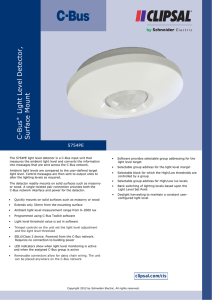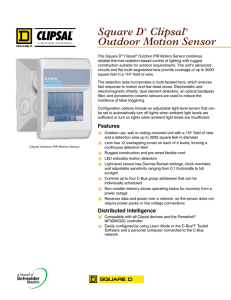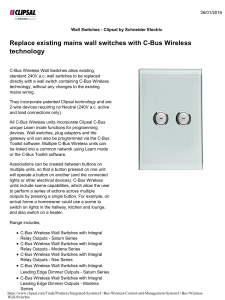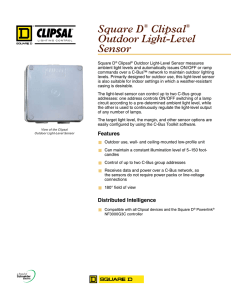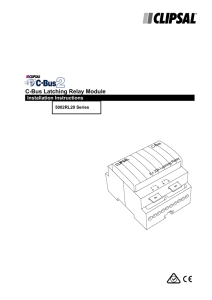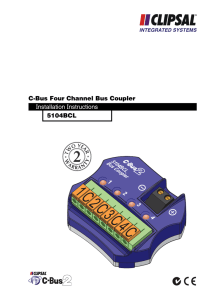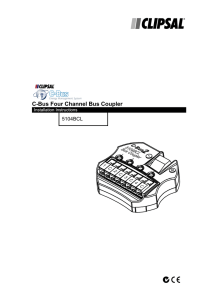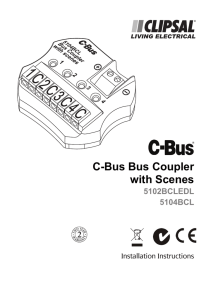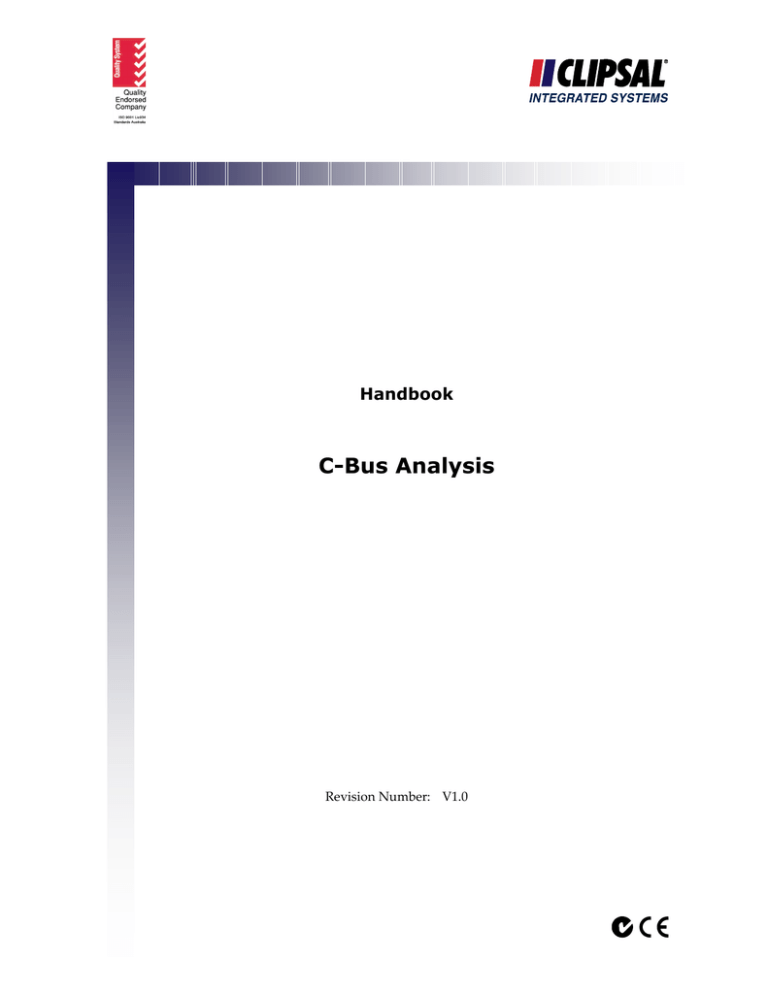
Handbook
C-Bus Analysis
Revision Number: V1.0
© Copyright Clipsal Australia Pty Ltd (CAPL) 2006. All rights Reserved. This material is copyright under
Australian and international laws. Except as permitted under the relevant law, no part of this work may
be reproduced by any process without prior written permission of and acknowledgement to Clipsal
Australia Pty Ltd.
Clipsal and C-Bus are registered trademarks of Clipsal Australia Pty Ltd.
The information in this manual is provided in good faith. Whilst Clipsal Australia Pty Ltd has
endeavoured to ensure the relevance and accuracy of the information, it assumes no responsibility for
any loss incurred as a result of its use. Clipsal Australia Pty Ltd does not warrant that the information
is fit for any particular purpose, nor does it endorse its use in applications which are critical to the
health or life of any human being. Clipsal Australia Pty Ltd reserves the right to update the information
at any time without notice.
V1.0 April 2006
Contents
Scope
Learning Outcomes
1.0
2.0
3.0
4.0
5.0
6.0
Analysis Tools
1.1
C-Bus Network Analyser
1.2
Multimeter
1.3
Cathode Ray Oscilloscope
1.4
Diagnostic Utility
1.5
HyperTerminal
3rd Party Devices
2.1
Typically Used 3rd Party Devices
2.2
Identifying 3rd Party Device Interference
C-Bus Clock
3.1
Old C-Bus Clock
3.2
New C-Bus Clock
3.3
No C-Bus Clock
3.4
MMI Status Check
Network Burden
4.1
Network burden Construction
4.2
Hardware Burden
4.3
Software Burden
Units Per C-Bus Network
5.1
Network Impedance
5.2
Current Consumption
5.3
C-Bus Calculator
C-Bus Voltage
6.1
Short To Earth
6.2
Short Circuit
6.3
Open Circuit
6.4
Insufficient Power Supplies
5
5
6
7
8
8
9
11
14
15
15
16
17
17
18
18
19
20
20
20
21
22
22
22
23
24
24
25
25
7.0
8.0
9.0
C-Bus Voltage
7.1
Cable Pairs
7.2
Cable Length
7.3
Cable Current Rating
Mains Voltage Supply Conditions
8.1
Cable Pairs
8.2
Cable Length
8.3
Cable Current Rating
Analysing A C-Bus Network
9.1
Third Party Interface Questions
9.2
C-Bus Clock Questions
9.3
Network Burden Questions
9.4
C-Bus Unit Questions
9.5
C-Bus Cable Questions
9.6
C-Bus Power Supply Questions
9.7
C-Bus Cable Run Questions
26
27
27
27
28
29
29
29
30
31
31
31
32
32
33
33
C-Bus Analysis
Scope
This handbook has been designed to provide a C-Bus installer or programmer with basic
diagnostic skills, needed to analyse a C-Bus installation. A fundamental technical background is
required.
It is preferred that the installer or programmer has attended a C-Bus Basic Training Course,
before using this handbook.
To get the most out of this manual, be sure to read all chapters carefully.
Learning Outcomes
By the end of this module, you should have an understanding of:
• the various tools used in the analysis of a C-Bus network
• the effect of 3rd party devices on a C-Bus network
• the construction of the C-Bus clock waveform
• the effect of a network burden on a C-Bus network
• the effect of C-Bus devices on a C-Bus network
• the effect of various voltage conditions on a C-Bus network
• the effect of C-Bus cable length on a C-Bus network
• the effect of mains voltages on a C-Bus network.
Handbook
5
C-Bus Analysis
1.0
Analysis Tools
There are a number of various tools and software packages that may
be used to analyse a C-Bus Network. These tools include:
• C-Bus Network Analyser
• Multimeter
• Cathode Ray Oscilloscope
• C-Bus Diagnostic Utility
• HyperTerminal.
These tools may be used to assess the correct operation of a C-Bus
Network, so that the customer is left with a flawless installation.
Handbook
6
C-Bus Analysis
1.1
C-Bus Network Analyser
The C-Bus Network Analyser (5100NA) is a tool, which is used to analyse the conditions of an
existing network. To use it, simply connect it to C-Bus via the terminals provided. Wait for five
seconds and all of the LED’s will come on. This indicates that the Network Analyser is
functioning correctly.
Figure 1: The C-Bus Network Analyser.
Each LED on the Network Analyser indicates a certain condition. These conditions are listed
below.
LED
Status Of LED
Check / Action
Power Available
Off / Flash
Check C-Bus power is available. If Led flashes add
power supply.
Clock Not Present
On
Check the PC Interface and Bridge connections.
Excess Voltage
On
Remove C-Bus Power Supply Units.
Remove Burden
On
Remove Network Burden.
Add Burden
On
Add Network Burden.
Excess Cable
On
Reduce Cable Length or split Network
Table 1: Network Analyser Indicators
The push button on the Network Analyser, adds a Network Burden to the C-Bus network. This
Network Burden is found inside the Network Analyser, and will be removed as soon as the
push button is released. This function is used to test to see if the network impedance is within its
tolerance.
If the Add and Remove Network Burden LED’s are flashing alternately, then this indicates that
the network is within a stable tolerance.
When the C-Bus Network Analyser is connected to any C-Bus Network, it temporarily
disturbs all C-Bus communications on the bus and causes temporary instability.
Handbook
7
C-Bus Analysis
1.2
Multimeter
The Multimeter is one of the most versatile and easily accessible measurement instruments. It
has a number of functions, which can test a C-Bus network for unexpected behaviours using the:
• Ohm Meter
• DC Voltage Meter
• AC Voltage Meter
• Audible Continuity Test.
When using a Multimeter, remember to test the C-Bus Network at various points by using
successive approximation. This will help identify any unexpected conditions along the C-Bus
network.
1.3
Cathode Ray Oscilloscope
A Cathode Ray Oscilloscope (CRO) is another vital tool used in C-Bus Network Analysis. It is
more complicated to use than a multimeter, but it allows the user to perform advanced readings
and measurements, that would be unable to achieve using other measurement instruments.
A CRO will be able to view the:
• C-Bus clock
• AC voltage waveform
• DC voltage waveform
• waveform frequency and period
• MMI Communications
• effect of a network burden
• any other unexpected behaviour of the C-Bus clock.
Many digital CRO’s have an ‘auto scale’ feature, which takes the C-Bus waveform and optimises
it for the most accurate readings. Unfortunately all analogue CRO’s do not have this function to
take measurements, the user must know exactly to use this instrument.
With a mains rated probe or a current probe, a CRO can also be used to check mains voltage and
current on the mains part of a C-Bus Network.
Care must be taken when taking mains voltage measurements with a CRO, due to live
exposed mains cables. Only a fully qualified electrician should take these measurements.
Handbook
8
C-Bus Analysis
1.4
Diagnostic Utility
The C-Bus Diagnostics Software allows the user to set the mode of a C-Bus Interface (serial or
Ethernet), to send or receive C-Bus commands. This allows the programmer or installer to
observe the C-Bus network traffic.
The Diagnostic Utility generates a list, which shows the transmitted data and received data.
Transmitted data is the data sent by the user to C-Bus via the C-Bus interface. Received data is
the data which is generated by a unit on the C-Bus network.
The C-Bus Diagnostic Utility is available for a free download from the downloads page, on the
Clipsal Integrated Systems website.
Figure 2: The C-Bus Diagnostic Utility software.
Handbook
9
C-Bus Analysis
1.4.1
Diagnostic Utility Setup
To set up the software for use, follow the steps below:
1) Click on the ‘Options’ menu
2) Select ‘Program Options’
3) Select the appropriate C-Bus interface parameter and click the ‘OK’ button
4) Click on the ‘C-Bus’ menu
5) Select ‘Connect C-Bus.’
Once the software has successfully connected to a PC Interface, a similar message to Figure 3
will appear.
Figure 3: The Information window indicates successful connection to C-Bus.
1.4.2
Using the C-Bus Diagnostic Utility
The C-Bus Diagnostic Utility can be used to:
• set the C-Bus interface into various modes
• perform Installation, Application and Level MMI’s
• identify any C-Bus unit on the network
• get the PC Interface Data
• monitor C-Bus commands via the Traffic Analyser
• control C-Bus with the Command Generator.
For further details on how to use the C-Bus Diagnostic Utility, consult the help files in the
software.
Handbook
10
C-Bus Analysis
1.5
HyperTerminal
When using HyperTerminal, please consult a CIS Representative or a Technical Support
Officer for help. It is strongly recommended that HyperTerminal is only used by
experienced C-Bus installers or programmers. It should only be used as a last resort in
diagnosing cosmetic faults on a C-Bus Network.
HyperTerminal can be a vital tool when analysing communications along a C-Bus Network. It
can monitor the C-Bus protocol and read commands sent down the network. It also allows you
to type in commands to send through the bus.
1.5.1
HyperTerminal Setup
HyperTerminal can connect to a:
• PC Interface
• C-Bus Network Interface.
To connect to a PC Interface, select the relevant COM Port in the ‘Connect To’ window, and
configure the COM Port properties to:
• Bits Per Second: 9600
• Data Bits: 8
• Parity: None
• Stop Bits: 1
• Flow Control: None
To connect to a C-Bus Network Interface, select TCP/IP (Winsock) in the ‘Connect To’ window.
The ‘Host Address’ is the IP Address of the C-Bus Network Interface, and the ‘Port Number’ is
the Port Number of the C-Bus Network Interface.
In the Property setting it would be best to enable “Send line ends with line feeds,” and
“Echo typed characters locally,” in the ASCII Setup page. This will allows the user to see
everything that is typed in, and everything that is sent to the computer.
Handbook
11
C-Bus Analysis
1.5.2
Smart Mode
Entering random strings should not be done unless familiar with the C-Bus protocol.
Sending bogus strings onto C-Bus may damage the firmware of various units, voiding all
warranties.
There are several modes that a C-Bus Interface can be put into by using HyperTerminal.
Generally for this type of application, Smart Mode is used. Smart Mode allows HyperTerminal
to display and send C-Bus protocol.
The C-Bus Interface will only go into Smart Mode, if the C-Bus Interface’s firmware
is V3.0 or later. Firmware version V3.0 was implemented October 1999.
To put the C-Bus Interface into Smart Mode, type in the pipe characters (eg. |||) followed by a
Carriage Return (Enter).
1.5.3
Sending C-Bus Commands
When sending C-Bus commands from HyperTerminal, ensure that there are no errors. If
an incorrect character is typed in then simply press enter (carriage return) and start
again.
This example is assumes that the C-Bus Group Addresses 00 on the Lighting Application
is being used.
Before you begin to analyse the network using HyperTerminal, put the PCI into Smart Mode. To
turn a group address on type in “\05380079XX,” where XX is the C-Bus group address in
hexadecimal addressing. This string is then followed by a carriage return (Enter Key).
On completing this you should see that group address physically turn on. To turn off the same
group address, type in “\05380001XX.” Once again after completing this, the designated load
should turn off as shown in Figure 4.
Figure 4: Sending C-Bus commands.
Handbook
12
C-Bus Analysis
1.5.4
Receiving C-Bus Commands
To receive C-Bus commands, ensure that the C-Bus Interface is in smart mode.
Once in smart mode, if any C-Bus unit on the network generates a C-Bus command, a C-Bus
string will appear in HyperTerminal as shown in Figure 5.
By receiving commands a user can determine which unit is generating the C-Bus
command. In the string 050138007900XX where XX is a checksum, 01 is the Unit Address
from where the command generated.
Figure 5: Receiving C-Bus commands.
Handbook
13
C-Bus Analysis
2.0
3rd Party Devices
Before analyzing a C-Bus network for correct operation, check for
any third party devices connected to the C-Bus network. Awareness
of any 3rd party devices is important, because the devices may
interfere with normal C-Bus operation.
Handbook
14
C-Bus Analysis
2.1
Typically Used 3rd Party Devices
Before analysing a C-Bus network for correct operation, check for any third party devices
connected to the C-Bus network. Third party products include devices such as:
• AMX
• Crestron
• Concept Panel
• and many others.
2.2
Identifying 3rd Party Device Interference
If the C-Bus network behaves unexpectedly on a network that has 3rd party interfaces attached to
it, then remove the devices to test the integrity of the C-Bus network. If the problem is no longer
there, then the integration with the third party device is causing the unexpected behaviour.
Handbook
15
C-Bus Analysis
3.0
C-Bus Clocks
A Cathode Ray Oscilloscope (CRO) is used to view the C-Bus clock
on a C-Bus Network. The C-Bus clock is a 5 V AC pulse that is
superimposed onto a 36 V DC C-Bus Voltage.
It is recommended that there be more than one C-Bus clock enabled
on each Network to provide a fully redundant C-Bus Network. The
C-Bus clock can be enabled on:
• Any C-Bus Unit with a PCI Simulator eg. C-Touch, PCI,
Telephone Interface etc.
• Any C-Bus output device.
When analysing the C-Bus clock with a CRO, there are a number of
things to look for:
• A single C-Bus clock pulse with a period of 2 ms or 500 Hz
• That the C-Bus clock’s amplitude measures 5 V AC
• A clean waveform (no noise or hum on it)
• That the discharge time of the positive cycle does not decay
over a long time
• The rising edge of the negative cycle is almost perfectly
vertical
• That there is no ringing on the waveform.
• That there isn’t much overshoot on the positive part of the
waveform.
Handbook
16
C-Bus Analysis
3.1
Old C-Bus Clock
Figure 6 is an example of the typical C-Bus clock. It is a 5 V p-p square waveform. This
waveform will vary, depending on the cable capacitance on the network. A large cable
capacitance will increase the discharge time on the positive cycle of the waveform. To reduce the
discharge time of the positive cycle of the clock, simply add a Network Burden.
Figure 6: Old C-Bus clock waveform.
3.2
New C-Bus Clock
Figure 7 is an example of the new C-Bus clock which is found on most new units. Note that the
waveform has more of a rounded appearance, rather than a square wave.
The new circuitry of the C-Bus clock, enables the C-Bus unit to have a better control over the rise
and fall of the clock. It also has the ability to handle the cable capacitance of larger networks
better. This results in less overshoot, ringing or waveform distortion.
Figure 7: New C-Bus clock waveform.
Handbook
17
C-Bus Analysis
3.3
No C-Bus Clock
If there is no active C-Bus clock enabled on the C-Bus network, then there will be no
communications. There is an algorithm in the C-Bus units that checks to see if a C-Bus clock has
been enabled. If there is more than one clock enabled on the C-Bus Network, then the C-Bus
units will see this and disable as many clocks as needed. This process is automatic and usually
takes any time between 1 second to around 2 minutes (depending on the network
characteristics).
It is recommended that no more than 3 C-Bus Clock be enabled. This will avoid communication
delays after the C-Bus Network is powered up.
3.4
MMI Status Check
Whilst examining the C-Bus Network with a CRO, notice the waveform has communications
data sent along the bus approximately every 3 seconds as shown in Figure 8. This 3 second data
transmission is the status report interval. The data transmission can be determined by SR
Interval (Status Report Interval), in the graphical user interface of most C-Bus input units.
Figure 8: MMI status check waveform.
This is how C-Bus communicates and is a normal operation. Every time the network sends data
onto the bus, the MMI (Multipoint to Multipoint Instruction) will check that all group addresses
are in sync.
A similar waveform will be displayed on the CRO if:
• a command is being sent on the bus
• a scan of the network is performed by Toolkit or C-Gate (the data transmission will be
much more intense).
Handbook
18
C-Bus Analysis
4.0
Network Burden
A Network Burden applies a standard impedance to a C-Bus
Network. It consists of a 1 kΩ 0.6 W resistor in series with a 10 uF
50 V capacitor.
The Network Burdens may be hardware or software, and should
only be used to limit the network to an impedance between 400 Ω
and 1.5 kΩ.
Handbook
19
C-Bus Analysis
4.1
Construction
A network burden consists of a 1 kΩ 0.6 W resistor in series with a 10 uF 50 V capacitor as
shown in Figure 9.
10uF to
22uF 50V 1kΩ 0.6W
+ C-Bus
- C-Bus
Figure 9: Construction of a network burden.
The Network Burden may be hardware or software, and should only be used to limit the
network impedance to be between 400 Ω and 1.5 kΩ.
4.2
Hardware Burden
The Hardware Burden comes in an RJ45 package (5500BUR). The hardware burden is designed
to be connected to any Din Rail units. It can be manually added or removed.
Ensure that when a hardware burden to a C-Bus network a click is heard, indicating that the
connection between the network burden and the RJ45 socket is secure.
4.3
Software Burden
The Software Burden can be enabled and disabled from the Toolkit Software or Learn Mode.
When using a software burden make sure that it is enabled at Unit Address 01. Check all units
for an enabled software burden to make sure only one burden enabled in the GUI. There may be
multiple software burdens enabled on various units due to poor programming.
If you have a burden enabled at Unit Address 01 and you change its Unit Address, the
burden is still active. In the global tab of the GUI, the burden setting will be enabled, but
greyed out. To disable it, you will need to change the Unit Address back to 01, or disable
it through Special Function Mode (see Learn Mode Application Notes).
The number of burdens on a C-Bus network is dependant on the construction of the network.
Typically all networks will need one network burden to function correctly. In some instances, no
burden may be needed. This is common when the network has approximately 60 C-Bus units.
Handbook
20
C-Bus Analysis
5.0
C-Bus Units Per Network
As a rule of thumb, it is generally accepted that a single C-Bus
network should not exceed a unit count of 100 units. However, there
is an exception to this.
There are two factors that effect how many units may be connected
to C-Bus Network. They are:
• network impedance
• current consumption.
Handbook
21
C-Bus Analysis
5.1
Network Impedance
The C-Bus network impedance is an important parameter that affects the way a C-Bus network
operates. As mentioned in Chapter 4, the ideal network impedance is between 400 Ω and 1.5 kΩ.
Usually Clipsal Integrated Systems will specify 100 units per network, because 100 C-Bus units
will bring the network impedance to its limit. Unfortunately 100 units may not be a realistic unit
count, due to the current consumption of the bus.
5.2
Current Consumption
The maximum current consumption of the bus affects the operation of C-Bus. A maximum of
2 A is allowed per C-Bus network. This is the equivalent of 10 Din Rail units with onboard
power supplies.
To calculate the maximum number of C-Bus units allowed on a C-Bus network, add the current
consumption of all the Input, System Support Units and Outputs without power supplies (the
current consumption can be found on the label of the C-Bus unit). The total current of all of the
calculated devices must not exceed 2 A.
5.3
C-Bus Calculator
The C-Bus Calculator is found in Toolkit. It is a useful tool that calculates the characteristics of
the C-Bus network that is being programmed. In Toolkit, each C-Bus network will have a unique
calculation. To view the calculations:
1) add all C-Bus units to the database in Toolkit (including stand alone power supplies)
2) place the Catalogue Number of each unit into the corresponding Graphical User
Interfaces in Toolkit
3) click on the desired network in the project manager, to view the calculations.
The main pane will then list the parameters that the C-Bus Calculator has calculated, as shown
in Figure 10.
Figure 10: The Toolkit C-Bus calculator.
Handbook
22
C-Bus Analysis
6.0
C-Bus Units Per Network
At any point in the Network, the voltage across a C-Bus Unit must
be in the range of 15 V DC to 36 V DC inclusive. However, a C-Bus
voltage as low as 15 V DC, may cause unstable communications. As
a rule of thumb, it is strongly recommended that the average C-Bus
voltage be no lower than 20 V DC.
When designing a single network topology, evenly distribute
C-Bus Power Supplies along the network. This will ensure
minimal voltage drops over the C-Bus cable.
Low C-Bus Voltage may be due to: • not evenly distributing C-Bus power supplies
• not using the correct C-Bus cable
• poor termination of C-Bus cable, causing multiple high
resistance joints
• not using the correct pairs of the Cat-5 (cable)
• not enough power supplies on the network
• too many C-Bus units on the network
• faulty C-Bus power supply.
Handbook
23
C-Bus Analysis
6.1
Short Circuit To Earth
When approaching a C-Bus network for the very first time it is important to check C-Bus cable
has not been shorted to earth.
Using a multimeter on the DC Voltage setting, place the negative probe onto true earth and the
positive probe onto the negative C-Bus rail. The multimeter should read roughly –15 V DC.
Following this, place the negative probe onto true earth and the positive probe onto the positive
C-Bus rail. The multimeter should read roughly +15 V DC. As C-Bus utilises a floating bus
voltage.
If the C-Bus is shorted to earth in any of these two tests, the multimeter will roughly read
either +30 V DC or –30 V DC.
Therefore when the multimeter probes are placed directly across the terminals of C-Bus, the
multimeter should read approximately 30 V DC.
6.2
Short Circuit
A short circuit on a C-Bus Network is a result of an incorrect installation. A short circuit will
cause the C-Bus voltage to drop to 0V at the point of the short. However, there may be a rather
small voltage on the bus at other points. The symptoms of a short on a C-Bus Network would
be:
• all LED’s on input units are off
• all C-Bus indicators on output units are off
• the C-Bus Voltage is 0 V.
The most common short circuit conditions are results of:
• incorrect C-Bus pairs used on installation
• loose C-Bus terminations shorting to another potential
• moisture partially shorting two terminals
• foreign objects shorting C-Bus terminals.
One of the first tests that should be conducted to identify a short circuit condition, is to take
voltage measurement using a multimeter. A short circuit condition should indicate that there is
0 V on the C-Bus network.
Handbook
24
C-Bus Analysis
6.3
Open Circuit
An open circuit condition is yet again another symptom of an incorrect installation. An open
circuit may cause units on a particular side of the C-Bus Network not to operate. However, if
there are power supplies and C-Bus clocks enabled on both sides of the open circuit, both sides
of the break will operate as two separate C-Bus networks.
Finding an open circuit may be difficult to diagnose because some parts of the C-Bus network
may still be operational. Finding an open circuit is most commonly found by using successive
approximation. This is means that the C-Bus network will be broken into sections for testing.
Successive approximation, may be executed by following the steps below:
1) break the network at the half way point
2) identify which half of the network is not operating as expected
3) take the half of the C-Bus network that is not operating correctly and half it again
4) identify which part of the network is not operating as expected
5) continue this process until the open circuit had been found.
6.4
Insufficient Power Supplies
A C-Bus network that has insufficient C-Bus power supplies is result of incorrect network
design. If the amount of C-Bus units is consuming more current than the C-Bus power supplies
can provide, then the C-Bus voltage will be low. This can be rectified by adding more power
supplies to the C-Bus network(ensuring the current on the C-Bus network does not exceed 2 A).
C-Bus units are designed to operate from the C-Bus Power Supply with a nominal loaded output
voltage of 36 V DC. As more C-Bus units are added to the network, the output voltage of the
C-Bus power supply starts to decrease. Voltage will also drop over large lengths of cable. This
voltage drop is proportional to the cable length and the current consumption.
Output
Voltage
36 V DC
32 V DC
Number of
C-Bus Units
C-Bus
Units
Figure 11: Maximum number of C-Bus units per power supply.
Handbook
25
C-Bus Analysis
7.0
C-Bus Cable
All C-Bus Networks use an Unshielded Twisted Pair (UTP), Cat-5
(cable) as the communications medium. The Clipsal catalogue
number for this product is 5005C305B.
The C-Bus cable is coloured pink so it is easily identifiable, in
comparison to any other Cat-5 (cable) eg. Ethernet. The cable has a
mains rated insulated outer sheath. This allows the cable to be safely
wired into a distribution board where mains are present.
Handbook
26
C-Bus Analysis
7.1
Cable Pairs
The following conductors of the CAT-5 (CABLE) cable must be used to make the C-Bus
connections:
• Orange & Blue:
(+) Positive C-Bus Rail
• Orange / White & Blue / White:
(-) Negative C-Bus Rail
Using the correct pairs increases immunity to electro-magnetic interference. This means
that the C-Bus cable is less susceptible to picking up noise.
7.2
Cable Length
On a C-Bus Network, there must be no more than 1000 metres of C-Bus Cat-5 (cable) used. This
is determined by the propagation delay of the C-Bus communications, and the total cable
capacitance of 100 nF. Large cable lengths can introduce effects on the network such as: • a drop in voltage
• an increase in cable capacitance.
The voltage drop will occur because the Cat-5 (cable) has a resistance of 90 Ω per 1000 meters. To
minimise the amount of voltage drop along large lengths of cable, evenly space out the C-Bus
power supplies along the C-Bus Network.
A high cable capacitance is a result of large lengths of Cat-5 (cable). This will cause the C-Bus
clock to distort. This is easily rectified by adding or removing a Network Burden (this may vary
with different C-Bus Networks).
Figure 12: The effect of cable length on a C-Bus clock.
7.3
Cable Current Rating
The maximum amount of current allowed to flow onto the Cat-5 (cable) is 2 A. This is a
limitation of the cable. If 2 A is exceeded then you will run the risk of damaging the C-Bus cable.
Therefore if high resistance joints are at both ends of a length of C-Bus cable, the cable will only
be able to carry 1 A instead of 2 A.
Handbook
27
C-Bus Analysis
8.0
Mains Voltage Supply Conditions
The mains supply to a C-Bus device is just as important as the C-Bus
supply. Unfortunately mains power cannot be controlled by an end
user, so it is important to know how mains voltage may effect a
network.
Handbook
28
C-Bus Analysis
8.1
Isolated Generators
All C-Bus units that are mains powered are designed to operate from a sinusoidal voltage
waveform. If an Inverter Supply (that produces a square wave voltage) is used, then C-Bus units
may not behave as expected and may damage the C-Bus unit.
An Uninterruptible Power Supply (UPS) may be used, if the output voltage and frequency are
within acceptable limits for C-Bus units that require mains power. These limits are:
• that the UPS must operate between the voltages 190 V and 265 V
• that the UPS must maintain a frequency of 50 Hz or 60 Hz, ±3 Hz
• the frequency may only vary by 3 Hz over 1 minute.
C-Bus Dimmers are the only C-Bus units that are effected by the shift of voltage and
frequency.
8.2
Brownouts
A brownout is a condition where a lower than normal mains voltage, is being supplied by the
local energy utility. A power line voltage reduction of 8 to 12 % is usually considered a
brownout. Unfortunately Clipsal Integrated Systems has no control over a brownout, as it is
usually caused by the local energy supplier.
During a brownout, electronic equipment may experience errors due to an erratic power supply.
Other electronic equipment may function poorly or not function at all.
Most C-Bus units (with power supplies) use switch mode power supplies, which are more
immune to mains voltage changes. If the mains input voltage decreases, the output will remain
the same voltage.
C-Bus Professional Series Dimmers do not use switch mode power supplies. If the mains voltage
on a C-Bus Professional Series Dimmer drops, the output of that power supply will drop by the
same percentage.
8.3
Overvoltages And Transients
All C-Bus units consist of electronic components that may be damaged by overvoltages and
transients. C-Bus does provide some level of protection to units, but not enough to protect them
from large inrush currents or lightning strikes.
It is recommended that overvoltage protection is used in the distribution board, to protect the
C-Bus units from overvoltages and transients. If the C-Bus cable is routed between buildings or
used in an outdoor installation, then protection must be used on the Cat-5 (cable) as well.
Handbook
29
C-Bus Analysis
9.0
Analysing A C-Bus Network
When analysing a C-Bus network, there are a series of questions that
an installer or programmer should ask their selves. These questions
relate to:
• 3rd Party Interfaces
• C-Bus Clocks
• Network Burdens
• C-Bus Units
• C-Bus Cable
• C-Bus Power Supplies
• C-Bus Cable Runs.
This chapter identifies some of the questions each C-Bus installer or
programmer should be asking them selves, when analysing a C-Bus
network.
Handbook
30
C-Bus Analysis
9.1
Third Party Interfaces Questions
Before testing the C-Bus network, ensure all third party devices are disconnected from the C-Bus
network. This will remove the possibility of the third party devices causing problems.
Questions that will assist in analysing the C-Bus networks are:
1) Are there any third party devices connected to the C-Bus network?
2) If so, what devices are connected?
3) Does the C-Bus network operate correctly once the third party device has been removed?
4) Is the function of the third party interface clearly understood?
5) What is the function of the third party interface?
9.2
C-Bus Clock Questions
If no C-Bus clock is enabled on a C-Bus network, then there will be no communications.
Questions that will assist in analysing the C-Bus networks are:
1) Is the C-Bus LED on the DIN Rail units on?
2) How many clocks are enabled on the C-Bus Network?
3) How many active clocks are there?
4) Are the units with the C-Bus clock enabled on them, physically located near each other?
5) Are there any clocks enabled on Network Bridges (5500NB) or C-Bus Network Interfaces
(5500CN)?
9.3
Network Burden Questions
Check all C-Bus devices for Hardware Network Burdens. Also check for Software Network
Burdens, by using the latest version of Toolkit software. Questions that will assist in analysing
the C-Bus networks are:
1) Does the C-Bus Calculator in Toolkit indicate that a Network Burden is needed?
2) How many hardware burdens are connected to the C-Bus network?
3) Have you checked all the C-Bus distribution boards for hardware Network Burdens?
4) Is the hardware burden used supplied Clipsal Integrated Systems?
5) What type of hardware Network Burden is being used (RJ45 or Flying Lead)?
6) How many software Network Burdens are enabled?
7) What is the unit type and unit address, of the unit with the software enabled Network
Burden?
8) Using toolkit, check the Global tab of each C-Bus unit, to see that there is a Software
Network Burden enabled.
9) Have you looked on the Status tab in Toolkit (and clicked the Update Status button) for
each C-Bus unit, to see if there is a Software Network Burden enabled?
Handbook
31
C-Bus Analysis
9.4
C-Bus Unit Questions
The following may be used to analyse how the C-Bus units affect the C-Bus system
requirements. Questions that will assist in analysing the C-Bus networks are:
1) Including C-Bus Power Supplies, how many C-Bus units are connected to the network?
2) Add up the current consumption of each C-Bus unit on the C-Bus Network. What is the
total current consumption for all these units?
3) Are there enough C-Bus Power Supplies to provide current for all the units on the
network?
9.5
C-Bus Cable Questions
The following may be used to analyse any possible wiring problems. Questions that will assist in
analysing the C-Bus networks are:
1) Has the recommended Cat-5 (cable) been used?
2) When running the C-Bus cable in parallel with 240 V mains cable, is there a minimum
segregation of 150 mm at all times?
3) When the C-Bus needs to cross 240 V mains cable, does it cross at a 90° angle with 60 mm
segregation?
4) What pairs of the C-Bus cable have been used for the positive and negative rails of
C-Bus?
5) Have any junctions been made on the C-Bus cable (using junction boxes etc)?
6) What is the exact length of the C-Bus cable, including patch leads?
7) Has the C-Bus cable been checked for broken conductors?
8) Has the C-Bus cable been checked for high resistant joins?
9) Has the C-Bus cable been checked for open circuits?
10) Has the C-Bus cable been checked for short circuits?
11) Has the C-Bus cable been checked for closed loops?
12) Does any of the C-Bus cable run underground, either in conduit or buried directly? If
yes, then does the installation of this cable meet national wiring standards?
Handbook
32
C-Bus Analysis
9.6
C-Bus Power Supply Questions
The following will help to identify any possible problems related to power supplies. Questions
that will assist in analysing the C-Bus networks are:
1) What is the mains voltage measured on the C-Bus power supplies?
2) How many stand alone C-Bus Power Supplies are there on the network?
3) How many on board C-Bus Power Supplies are there on the network?
4) Add up the current that each C-Bus Power Supply provides. What is the total current
supplied by all C-Bus Power Supplies?
5) Are the C-Bus Power Supplies concentrated in one general area?
6) Are the C-Bus Power Supplies evenly distributed throughout the installation?
7) Are there any old C-Bus Power Supplies (5100PS)?
9.7
C-Bus Cable Run Questions
The following will allow the analysis of problems with cable runs. Questions that will assist in
analysing the C-Bus networks are:
1) Is the network a standard daisy chain configuration?
2) If using a star configuration, how many branches are there on the network?
3) Are any of the voltages on all of the branches below 20 V DC?
4) What are the lowest voltages (measured on C-Bus units) on each C-Bus cable run?
5) Are any of the voltages on all of the branches above 36 V DC?
6) What are the highest voltages (measured on C-Bus units) on each C-Bus cable run?
Handbook
33

